








“How much more joy can you get out of life than being with your dog in a park?” Judy Trockel. 2018.
NRPA.org. Designing and Managing Innovative Dog Parks.
The City of Dallas Park and Recreation Department is committed to increasing the diversity of our recreation offerings throughout our neighborhoods. Increasing the number of dog parks in our communities will increase access to a highly popular interest among baby boomers, Gen Xers and millennials. 91% of Americans believe dog parks provide benefits to their communities.1
1 NRPA. 2018. NRPA Park Pulse: Americans Agree Dog Parks Benefit Local Communities.

Dog Park Design Guidelines are to be used by Dallas Park and Recreation Staff including but not limited to Planning, Design, and Facilities, Park Maintenance, Administrative and Finance, city vendors and the professional development community who partner with the department, and community stakeholders who contribute in making our dog parks a reality.

“Dog parks are among the fastest growing amenities park and recreation agencies offer,”said Barbara Tulipane, CAE, NRPA president and CEO. “Whether it’s allowing dogs a chance to play offleash or get exercise with their owners, having a safe space to roam freely benefits the surrounding communities.” - NRPA. 2018. Americans Agree Dog Parks Benefit Local Communities.
The Dog Park Design Guidelines establish minimum best practice design guidelines that ensure all dog park projects incorporate best practices for sustainability, resiliency, health, and safety. Within the document, all guidelines indicate a peer reviewed preference or recommendation. Projects are encouraged, but not required, to achieve these guidelines to the extent feasible. PKR recognizes that the Design Guidelines cannot address all scenarios. Pertinent laws, rules, regulations, and codes take precedence over the Guidelines in the event of a conflict. When unique or special circumstances, extraordinary market conditions, or special community characteristics necessitate deviation from any aspect of the Guidelines, the project manager must make note and explain the project constraints and the rationale behind design decisions when presenting to the community and to board, commissions, and council, where applicable.
Park and Recreation staff intends to review and release guideline updates every 3 to 5 years, as needed.
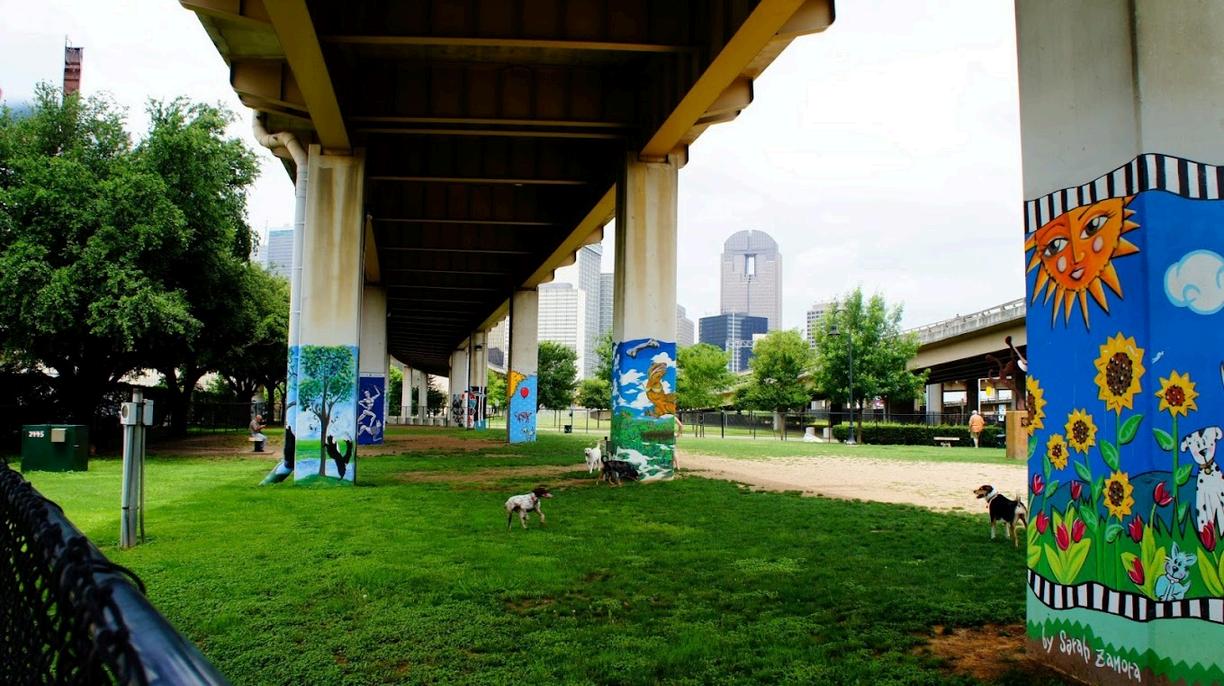


Dog Parks should be designed to meet the local community’s needs. When best practices are followed:
DOGPARKS ARE: PUBLIC CLEAN WELL MAINTAINED UNIQUE TO LOCATION ORGANIZED ACCESSIBLE SELF-GOVERNING SAFE SPACE AN ASSET SOCIAL
DOGPARKS ARE NOT: DIRTY UNHEALTHY LOUD ISOLATED REMOTE EXCLUSIONARY UNATTRACTIVE DANGEROUS UNPREDICTABLE A LIABILITY
As of 2025, the City of Dallas has a population of 1,299,553 people according to the Office of Economic Development(1) Based on our population, staff recommends that Dallas needs an estimated minimum of 13 accessible dog parks in the city. As of 2025, Dallas has 11 dog parks. Many of the dog parks are concentrated in downtown, where access to private yards are obsolete. Additional locations for our signature dog parks are located near White Rock Lake and in Northern Dallas.
SanDiego, CA
Houston, TX
San Jose, CA
San Antonio, TX
Denver, CO
Los Angeles, CA
Charlotte-Mecklenburg, NC
Phoenix, AZ
Austin, TX
Dallas, TX
Atlanta, GA
Philadelphia, PA
Fort Worth, TX
1.Office of Economic Development; 2021 American Community Survey 5-Year Estimate
2.Trust For Public Land. 2025. City Park Facts. Dallas, Texas. www.tpl.org

Every increment of construction must be made in a way as to heal the city. -Christopher Alexander
Site Analysis ensures the site of the dog park is located thoughtfully and strategically, not only for its technical design and construction needs, but also for the community’s enjoyment, ease of access, and proximity to other dog parks.

When reviewing new locations for dog parks, the following site design guidelines should be taken into consideration.
PROXIMITY: When deciding on a new location of a dog park. The Dog Park Level of Service should be taken into consideration. Priority should be given to new locations that fill service area gaps.
VISIBLE: Dog Parks should be visible to users, spectators, park rangers and patrol, but should be respectful of neighboring properties.
ACCESSIBLE: Centrally locate dog parks in neighborhoods that have diverse access options. This provides greater access for more users and their families, and may include ways to access the park through DART routes, pedestrian and bike trails, sidewalk connections, and streets.
WALKABLE: Take consideration to prioritize and capitalize on existing pedestrian connections to and from adjacent and surrounding neighborhoods, schools, and recreation centers via sidewalks or multi-purpose trails. This will reduce the need to drive to the site. Thereby, requiring less parking and allowing more of the site to be used for recreation.
SAFETY: Consider signage to encourage safe practices and use of the dog park related to size of dogs and community use and maintenance of the park. Fencing type and material should be selected to prevent dogs from escaping through fence openings or climbing/jumping over the fences. A fence height of four to six feet is recommended.
SOIL: Soil types on site should be tested and accessed for construction feasibility.
TERRAIN: Work with existing typography and elevation changes to enhance the design of the dog park.
DRAINAGE: Ensure proper stormwater management, including proper drainage connections by coordinating with DWU, access current and anticipate future floodplain and water table issues.
DISPLACEMENT OF TREES: Work around existing trees, establish proper mitigation barriers where necessary, and consider what trees need to survive, and which species drop seeds and branches into the park. Work with PKR arborists to mitigate and review design plans.
ENVIRONMENT: Do not locate dog parks in a designated conservation, natural or wildlife habitat area, or areas that will adversely affect fish and wildlife habitats. Work with PKR biologists to mitigate and review design plans.




“I thought that dog parks should be as interesting and fun as a well-designed children’s playground,” Smith continues. “I look at dog parks as a social space for both dog caretakers and the dogs themselves.”- Ken Smith. 2018. NRPA.org. Designing and Managing Innovative Dog Parks






The following design criteria should be taken into consideration when working together with communities and consultants to design a new, or renovate an existing dog park.
SCALE AND LOCATION: Ensure size and design are appropriate scale to existing and planned programming within the park and to adjacent surrounding uses. Dog Parks should have clear separation from playgrounds, residential areas and areas exposed to heavy traffic. Including safe distance from amenities such as picnic areas, athletic fields, and regional trails.
REST AND VIEWING AREAS: Provide a place for users to observe their dogs and others without feeling like they’re in the way or at risk of getting run into.
LIGHTING AND SHADE: Provide accessibility lighting for safety and greater usage at different times of the year. Incorporate shade sails, pavilions, etc. to provide shelter from hot or rainy weather.
COMFORT AND AMENITIES: Ensure budget and design include basic necessities like drinking fountains for people and pets, restrooms, wash stations, and agility equipment. Ensure amenities are constructed to mitigate corrosion risks.
MATERIALS: Dog parks should be designed to keep up with best practice trends, while ensuring low maintenance needs overall. This may include ground surface materials such as concrete and artificial turf as primary materials with natural surfaces such as sod or mulch in combination with concrete or artificial turf to achieve maintenance schedules. Amenity materials should be anti-corrosive where feasible.
SOUND: Use sound abatement design techniques by installing dog friendly greenery or building in topography elements.
MAINTENANCE: Install irrigation and insure proper drainage. Design and Construction Teams to coordinate with Park Maintenance District Managers for design approvals. Consider partnering with neighborhood organizations to assist in small maintenance needs

EXISTING SMALL DOG PARKS: Klyde Warren Park, Carpenter Park, Harwood Park, Main Street Garden, Lakeland Hills
SIZE: Less than one acre
LOCATION: Typically located in mid to high density neighborhoods
RECOMMENDATION:
Locate only in high density neighborhoods where residents lack access to private yards or green space.

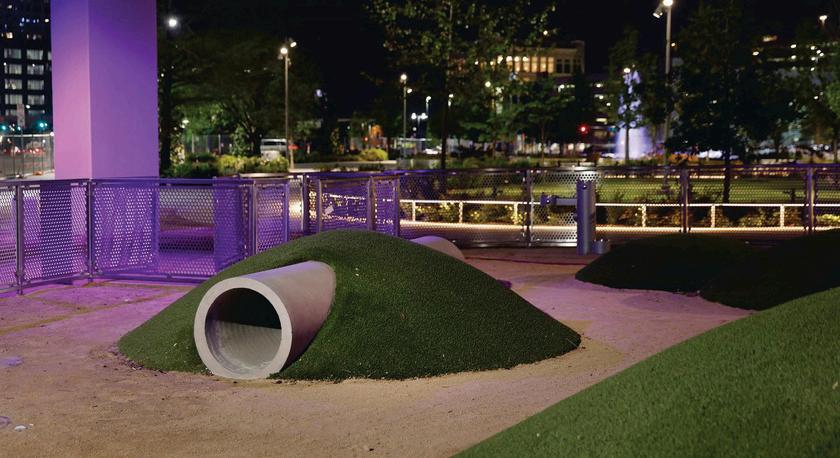
DESIGN FEATURES:
Artificial turf
Proper drainage
Irrigation
Shade provisions
Fencing
Signage
Water stations
Agility equipment
Waste stations
Lighting
Shown above, is a small dog run located under I-345 at Carpenter Park. Small dog parks, also known as dog ‘runs,’ are located primarily near higher density neighborhood where residents lack access to private yards or green space. Dog parks provide necessary relief areas for dogs, but also give opportunity for exercise, agility, and social interaction for our four legged friends.
DOG PARK DESIGN GUIDELINES

SIZE: one acre, maximum two acres
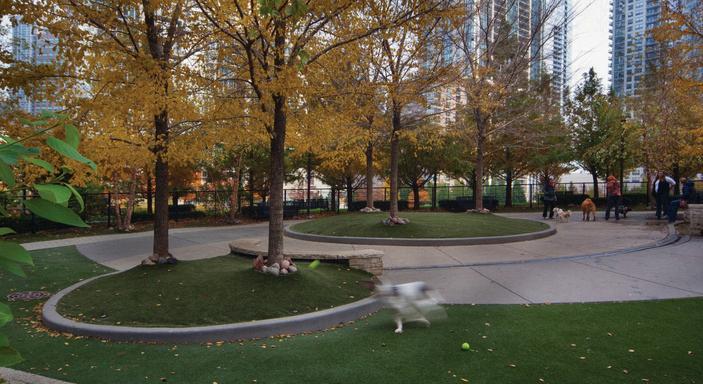
LOCATION: Typically designed as play and recreation areas in both low and mid density neighborhoods
RECOMMENDATION: Dog Parks built between one and two acres are ideal for affordable construction costs and sustaining maintenance overtime.
Artificial turf
Proper drainage
Irrigation
Shade provisions
Fencing
Signage
Water stations
Agility equipment
Waste stations
Seating areas

Shown above is a Dog Friendly Area at Lakeshore East Park in Chicago. Designed slightly less than one acre, the park includes washable surfaces such as concrete hardscapes and artificial grass, appropriate drainage, small and large dog paddocks, trees for shade with rock buffers to prevent digging, ornamental plantings for buffering fences, water stations, benches, and dog wash stations

EXISTING SIGNATURE DOG PARKS:
NorthBark
Wagging Tail
White Rock Lake
SIZE: Greater than 2 acres
LOCATION: Typically designed as play and recreation areas in both low density and rural areas
RECOMMENDATION: Signature dog parks larger than 2 acres are no longer recommended due to their high construction cost and long-term upkeep. This shift in design will support the development of new dog parks in neighborhoods currently lacking access. Additionally, new dog parks will not include water features such as ponds, lakes, creeks, or rivers, helping to ensure water quality and reduce maintenance demands.
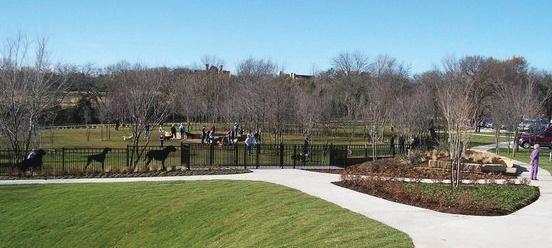
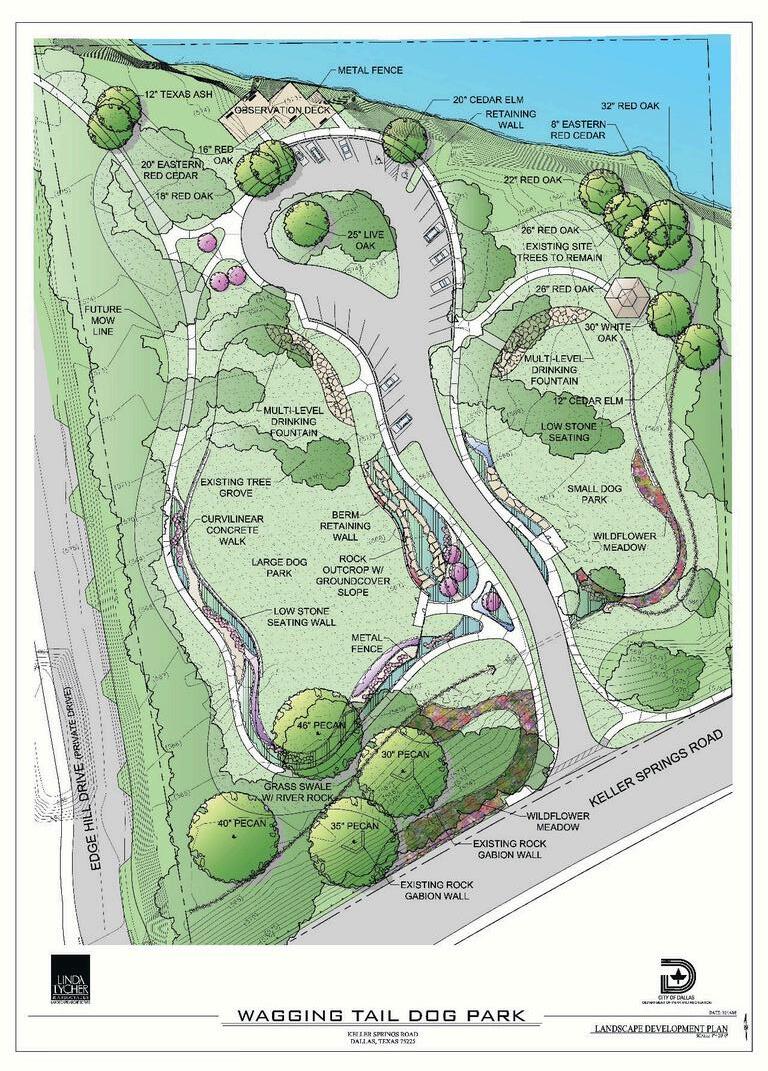
DESIGN FEATURES:
Natural and artificial turf
Enhanced water elements
Proper drainage
Irrigation
Shade provisions
Fencing
Signage
Water stations
Agility equipment
Waste stations
Seating areas
Designed with small and large dog areas including appropriate topography and planting plans for sound buffering of parking, enhanced by exterior walking trails, drinking fountains, seating areas and pavilions, and fencing This park is 6 9 acres in size and it’s success required an expansion in parking
DOG PARK DESIGN GUIDELINES

Engaging the community is key in finding support for new dog park locations Strong support and opposition from neighborhoods, is not uncommon, and education and transparency in the process is helpful when navigating a new neighborhood project.


In addition to analyzing land for site and design guidelines, successful steps towards meeting community and user needs include the following:
Involve all users and non-users in the conversation - neighbors, businesses, stakeholder groups, and canine organizations and veterinary services nearby
Community Analysis - economic and demographic
Locating nearby parks and schools for predicting user routes and travel times
Accessing traffic patterns and locations of emergency services for safety
Hold at least three community meetings.


Meeting 1: Provide basic information, gather interest, possible locations, record support, and concerns.
Meeting 2: Gather ideas from the user community about the scale of the park and the possible design elements. This may be best in the form of a design charrette. If a site has been selected, ensure the design suggestions are within the limitations of the topography Gauge interest or identify unique cultural community aspects to include in the design.
Meeting 3: Present design proposals for feedback and revisions

Published October 23, 2025